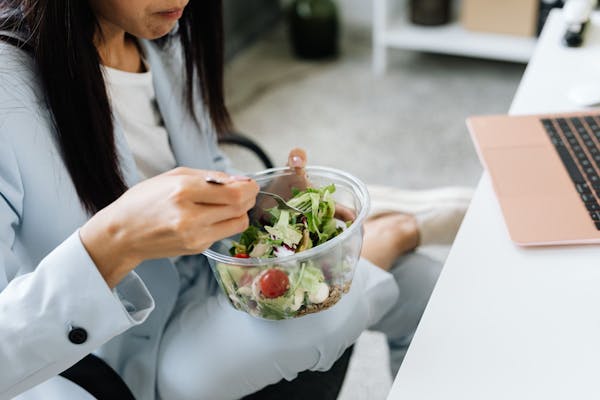Navigating Dietary Needs in the Modern Office

Written by CaterCow Staff • October 17, 2022

Navigating dietary needs in the modern office
Navigating dietary needs can be difficult, especially when you’re trying to organize an office meal with your team. Chances are, at least one person on your team has a dietary need that means a bulk order just won’t cut it.
Dietary needs describe more than just preferences or personal choices, they also include medical or health-related restrictions. The “modern office” means one that is respectful of all dietary needs, no matter the reason.
So what do terms like “vegan,” “paleo,” or “gluten-free” mean? It can be overwhelming to order for a large group of people with diverse diets, so it’s normal to have some questions. We’ve put together a simple guide so you can feel confident when you order your next group meal.
What’s the difference between vegan and vegetarian?
Many people don’t know the difference between veganism and vegetarianism - it doesn’t help that they both start with V! Here’s what each term means:
What do vegans eat?
When someone is vegan, they do not eat animal products. This means that their food choices avoid meat, eggs, butter, dairy, and much more. They prefer substituting plant-based ingredients for the typical animal-based foods. Sometimes, vegans extend their avoidance of animal products past food and also avoid leather goods, furs, or other animal-derived products. They do this so they can fully lead an ethical, environmentally-conscious lifestyle.
What do vegetarians eat?
Vegetarians, on the other hand, avoid eating meat. They still partake in eating other animal products like eggs, milk, butter, and more. While they aren’t completely plant-based, they don’t consume meat like chicken, pork, beef, or fish.
When ordering from a service like CaterCow, look for the icons that denote vegan or vegetarian. Trust us, it will make all the difference when it comes to your vegan or vegetarian colleagues feeling understood and valued when you order this type of food.
What foods are gluten-free?
More and more people these days are either gluten intolerant or suffer from an autoimmune condition called Celiac’s disease. This means that they experience physical symptoms and discomfort when they have gluten, which is a key component of wheat.
Foods that are gluten-free use other types of grains in their crusts, breads, wraps, or cakes. This could include rice flour, maize flour, chickpea flour, potato flour, and many other options.
What should I avoid when gluten-free?
When avoiding gluten, be sure to check the ingredients list for wheat or wheat flour. In previous generations, it would be near impossible to avoid gluten without completely cutting out breads. However, there are so many options and substitutes for wheat these days, so those that eat gluten-free can enjoy the same flavor and texture as their gluten-eating teammates.
Those who cannot have gluten often suffer from gastrointestinal symptoms, brain fog, or even feelings of panic when they have gluten. So, your gluten-free teammates will be a lot more comfortable physically and mentally if they can avoid this ingredient! They won’t have to worry about their stomachs making loud noises (or worse!) during their 2pm meeting.
What is the difference between “checked for nuts” and “nut-free” on a menu?
Believe it or not, there is a difference between “checked for nuts” and “nut-free” items. Those that are nut-free mean that the restaurant does not make any food that uses nuts, so there is a much smaller (but never zero!) chance of cross-contamination. “Checked for nuts,” on the other hand, means that each item on the menu will indicate whether or not it contains nuts. The “N” icon means that the item is made with nuts, while the items without the “N” are not. Keep in mind that food may have come in contact with nuts during preparation, as it’s very seldom that a restaurant can be completely traceless when it comes to this ingredient.
And yes, it’s confusing. But it makes a huge difference to individuals who have nut allergies when food items are clearly marked. Many people who have previously experienced terrible allergic reactions might even forgo the tastiest options if they can’t confirm that there are no nuts present - so don’t leave people hanging!
What is the keto diet?
The ketogenic diet, also called the keto diet, is a popular way of eating that helps individuals lose weight through a natural metabolic process called ketosis. Ketosis happens when individuals replace their carbohydrates with fats in their meals. So, the keto diet includes high fat foods and avoids carbs like sugar, grains, fruits, and starches.
Individuals who follow the keto diet may increase their intake of red meats and other fatty meats, but avoid eating pastas, pizzas, sandwiches, cakes, or other bready foods. While most people on the keto diet try to stick with it as much as they can, they can be a bit more flexible with what they eat than someone who has an allergy or intolerance. That said, those who eat keto would really appreciate having options for lunch that align with their dietary needs.
What is the paleo diet?
Instead of the science-y sounding keto diet, the paleo diet is one based on, well, history - distant history, think 10,000 years ago. The paleo diet’s premise is that by eating like the early humans did, we can physiologically live closer to our genetic functionality.
The paleo diet avoids foods that are generally created through farming, which wasn’t invented until more recent times in human existence. While it’s fair to say that farming took off faster than Silicon Valley’s hottest start-up and disrupted the food game completely, our genes have taken a bit longer to adapt to our lifestyles and diets. So, by eating what humans mainly ate before farming, those who eat paleo subscribe to a more basic diet.
The paleo diet avoids foods like dairy, processed grains, processed sugars, legumes, and potatoes. It includes foods like fruits, vegetables, meats, nuts, and seeds. When ordering paleo food, look for salads and other leafy dishes. Pro tip: avocado. Lots of avocado.
What does pescatarian mean?
Finally, let’s give you an easy one. Pescatarian simply means that a person doesn’t eat meat - except for fish. You can think of them as “vegetarian plus,” as they will generally eat meals that are vegetarian, but will also enjoy a cheeky plate of seafood.
What are the best ways to navigate dietary needs?
With many different dietary needs out there - allergies, intolerances, and lifestyle preferences - it’s hard to give steadfast rules that will always hit the mark when it comes to navigating food. However, here are a few considerations:
- Get a sense of the dietary needs of your office. By asking your team what their dietary needs are upfront, you’ll get a sense of how much of what kind of food to order. Incorporating a question about dietary needs in your onboarding process means that you always have a sense of what dietary needs there are across the company.
- Always offer a vegan or vegetarian option. Even if you don’t have any vegans or vegetarians on your team, not everyone wants to eat meat or other animal products at every meal. By offering a vegan and vegetarian option, you give everyone a choice. This is even more important if you have vegans or vegetarians within your company - they should always get to participate in group meals. Here’s a hack: all vegan food is vegetarian, so it might be easier to order a vegan dish instead of tracking down a vegan and a vegetarian meal!
- Be mindful about how you talk about dietary needs. Even if you don’t have any dietary needs, how you talk about them matters. Positioning dietary diversity as inconvenient will lead to disengaged, frustrated, and self-conscious teammates. You never know what the situation is or the motivation behind someone’s relationship with food. No one should feel bad for taking care of themselves or for following a lifestyle that’s important to them!
- Become savvy about the menu icons. Most restaurants have icons now on their menus for easy identification of foods that suit specific dietary needs. CaterCow marks all foods with the relevant icons so you can quickly find items to add to your order that suit the dietary needs of your office.
By taking the extra time to order foods that everyone can enjoy, you’re promoting an inclusive environment where everyone gets the opportunity to eat healthy and with their personal values respected. The modern office is one of diversity, and that includes dietary diversity. By understanding what different dietary needs are, you can make sure that everyone leaves the kitchen full and satisfied.



